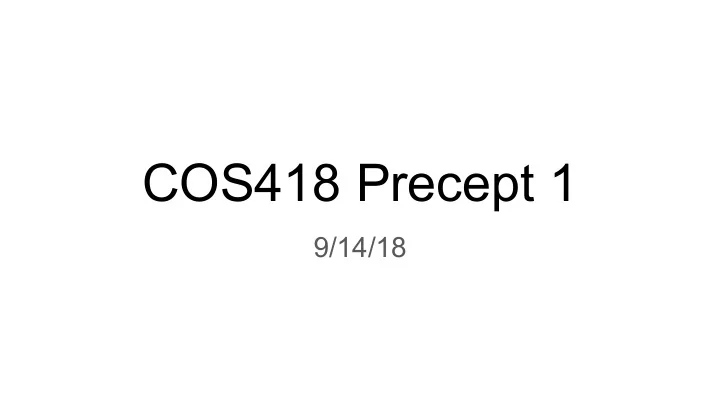

COS418 Precept 1 9/14/18
Resources: https://tour.golang.org/list https://play.golang.org https://gobyexample.com/
Basic syntax code in playground: https://tinyurl.com/y7rdgqj3
// All files start with a package declaration package main // Import statements, one package on each line import ( "errors" "fmt" ) // Main method will be called when the Go executable is run func main() { fmt.Println( "Hello world!" ) basic() add(1, 2) divide(3, 4) loops() slices() maps() sharks() }
// Function declaration func basic() { // Declare x as a variable, initialized to 0 var x int // Declare y as a variable, initialized to 2 var y int = 2 // Declare z as a variable, initialized to 4 // This syntax can only be used in a function z := 4 // Assign values to variables x = 1 y = 2 z = x + 2 * y + 3 // Print the variables; just use %v for most types fmt.Printf( "x = %v, y = %v, z = %v\n" , x, y, z) }
// Function declaration; takes in 2 ints and outputs an int func add(x, y int) int { return x + y } // Function that returns two things; error is nil if successful func divide(x, y int) (float64, error) { if y == 0 { return 0.0, errors.New( "Divide by zero" ) } // Cast x and y to float64 before dividing return float64(x) / float64(y), nil }
func loops() { // For loop for i := 0; i < 10; i++ { fmt.Print( "." ) } // While loop sum := 1 for sum < 1000 { sum *= 2 } fmt.Printf( "The sum is %v\n" , sum) }
func slices() { slice := []int{1, 2, 3, 4, 5, 6, 7, 8} fmt.Println(slice) fmt.Println(slice[2:5]) // 3, 4, 5 fmt.Println(slice[5:]) // 6, 7, 8 fmt.Println(slice[:3]) // 1, 2, 3 slice2 := make([]string, 3) slice2[0] = "tic" slice2[1] = "tac" slice2[2] = "toe" fmt.Println(slice2) slice2 = append(slice2, "tom" ) slice2 = append(slice2, "radar" ) fmt.Println(slice2) for index, value := range slice2 { fmt.Printf( "%v: %v\n" , index, value) } fmt.Printf( "Slice length = %v\n" , len(slice2)) }
func maps() { myMap := make( map [string]int) myMap[ "yellow" ] = 1 myMap[ "magic" ] = 2 myMap[ "amsterdam" ] = 3 fmt.Println(myMap) myMap[ "magic" ] = 100 delete(myMap, "amsterdam" ) fmt.Println(myMap) fmt.Printf( "Map size = %v\n" , len(myMap)) }
Exercises (easy) You can use the playground for this (https://play.golang.org) if you don’t have go installed locally. 1. Print the first 10 squared numbers. 2. Print the first 10 fibonacci numbers. 3. Fizzbuzz: Replace multiples of 3 with fizz and multiples of 5 with buzz ; replace multiples of both with fizzbuzz . Print the first 100 numbers in this sequence. 4. Write a function that reverses a slice. 5. Write a function that returns the number of unique items in a slice.
// Object oriented programming // Convention: capitalize first letter of public fields type Shark struct { Name string Age int } // Declare a public method // This is called a receiver method func (s *Shark) Bite() { fmt.Printf( "%v says CHOMP!\n" , s.Name) } // Because functions in Go are pass by value // (as opposed to pass by reference), receiver // methods generally take in pointers to the // object instead of the object itself. func (s *Shark) ChangeName(newName string) { s.Name = newName }
// Receiver methods can take in other objects as well func (s *Shark) Greet(s2 *Shark) { if (s.Age < s2.Age) { fmt.Printf( "%v says your majesty\n" , s.Name) } else { fmt.Printf( "%v says yo what's up %v\n" , s.Name, s2.Name) } } func sharks() { shark1 := Shark{ "Bruce" , 32} shark2 := Shark{ "Sharkira" , 40} shark1.Bite() shark1.ChangeName( "Lee" ) shark1.Greet(&shark2) // pass in pointer shark2.Greet(&shark1) }
// Launch n goroutines, each printing a number // Note how the numbers are not printed in order func goroutines() { for i := 0; i < 10; i++ { // Print the number asynchronously go fmt.Printf( "Printing %v in a goroutine\n" , i) } // At this point the numbers may not have been printed yet fmt.Println( "Launched the goroutines" ) }
// Channels are a way to pass messages across goroutines func channels() { ch := make( chan int) // Launch a goroutine using an anonymous function go func () { i := 1 for { // This line blocks until someone // consumes from the channel ch <- i * i i++ } }() // Extract first 10 squared numbers from the channel for i := 0; i < 10; i++ { // This line blocks until someone sends into the channel fmt.Printf( "The next squared number is %v\n" , <-ch) } }
// Buffered channels are like channels except: // 1. Sending only blocks when the channel is full // 2. Receiving only blocks when the channel is empty func bufferedChannels() { ch := make( chan int, 3) ch <- 1 ch <- 2 ch <- 3 // Buffer is now full; sending any new messages will block // Instead let's just consume from the channel for i := 0; i < 3; i++ { fmt.Printf( "Consuming %v from channel\n" , <-ch) } // Buffer is now empty; consuming from channel will block }
Exercises (medium+) Link to the playground: https://play.golang.org 1. Implement a binary tree in which each node contains a number. Then write a function that sums all the numbers in the tree. 2. Write a function that launches n goroutines to square all entries in a slice in parallel, where n is provided by the caller. Your function should block until all goroutines terminate. 3. Given an n by n matrix, print all entries in spiral order. Now do it in both directions (clockwise and anti-clockwise). 4. Implement mergesort using goroutines. If the size of the input slice is n , how many goroutines are launched in total?
Recommend
More recommend